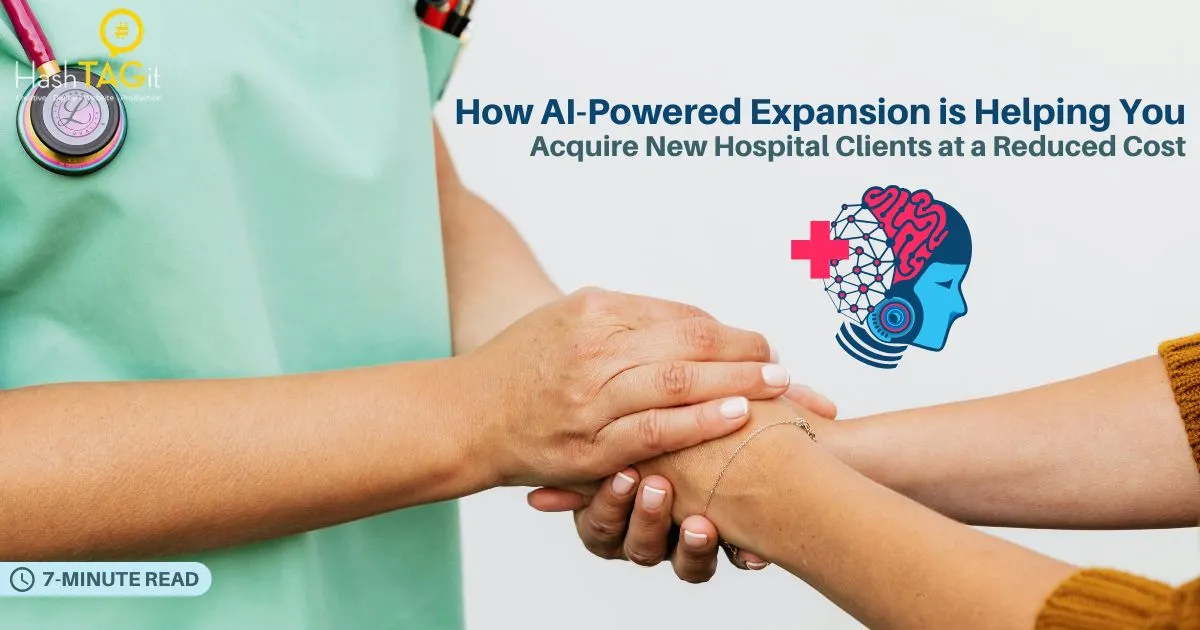
How AI-Powered Expansion is Helping You Acquire New Hospital Clients at a Reduced Cost in 2025
Like many other industries, the healthcare sector is going through a digital revolution. Hospitals and other healthcare facilities are under a lot of pressure to get new patients while also cutting costs. Ads in newspapers, on TV, and on billboards are all old-fashioned and expensive ways to reach the right people. Artificial intelligence (AI) is changing healthcare for the better by improving marketing, making outreach more personal, and making it easier for people to get involved. This helps hospitals lower their Customer Acquisition Cost (CAC).
This blog talks about how AI is helping hospitals get more patients, lower their customer acquisition costs (CAC), and make their marketing more valuable.
What is the Price of Acquiring New Patients in the Medical Field?
Getting New Customers: The cost is the total amount of money needed to add a new patient to the hospital system. This money goes towards digital marketing, sales teams, advertising, and customer relationship management (CRM) systems. If not optimised, CAC can cost hospitals thousands of rupees per patient, especially private and speciality centres.
It's hard to find the right balance between lowering CAC and keeping a high number of high-quality patients. This is where AI-Powered Expansion helps acquire new hospital clients lower CAC!
The Old and New Ways of Buying with AI
Hospitals used to use a lot of different ways to get the word out, like events, billboards, newspaper ads, bulk SMS, and referral bonuses. A lot of people see these ads, but they don't always get the right people to do something. For instance, Gen Zers who are into fitness might see an ad for joint replacement, and adults in their 60s might see an ad for kids.
Here are some ways that AI can help hospitals:
- Find patient groups that are interested in care
- Be very careful when running digital campaigns
- Try to predict how patient behaviour
- Don't spend money on channels that don't work
1. AI-Powered Predictive Precision Marketing
Artificial intelligence (AI) systems use a lot of information from patient records, demographic profiles, internet behaviour, and search trends to figure out who is most likely to need a certain type of medical care.
Precision Marketing AI can look for things like: • Women in Noida between the ages of 28 and 35 who are looking for the "best hospital for normal delivery" • Senior citizens who live within 10 kilometres of the hospital and need cardiac care • New parents who are looking into NICU care options in their area
Once you've found these small groups, you can use Facebook, Instagram, or Google ads to reach the right people at the right time. This cuts down on ads that don't work and gets better leads.
2. Personalised Patient Journeys
The same old email and text message campaigns don't work anymore. AI helps hospitals and clinics come up with unique ways to turn leads into real patients. For instance, when someone clicks on an ad for orthopaedic services, they get a WhatsApp message asking if they want to set up a consultation.
- A blog for pregnant women gives them advice and reminders based on how far along they are in their pregnancy.
- When a diabetic needs help, they are shown personalised content that includes doctor videos, testimonials, and different package options.
These AI-powered workflows keep more patients in the funnel, which raises conversion rates, automates follow-ups, and lowers CAC in the end.
3. Smart chatbots and virtual assistants
AI-powered chatbots are changing how hospitals talk to patients who may need medical care. They are open every day of the week.
- Answer questions right away
- Give doctors advice based on the symptoms Set up appointments as soon as possible
- Send out health packages, reviews, and instructions
By automating communication at the front desk, hospitals can cut down on the number of large call centre teams they need and make the patient experience better. There are fewer lost leads, and patients get quick answers.
4. Dynamic Advertising Improvement
AI tools like Google Performance Max and Meta Advantage+ can change budgets, creatives, and ad placements right away based on how well they are doing. AI lets hospitals do the following instead of sticking to a set campaign plan:
- Give more money to the areas or age groups that do the best
- Try out a few ads and let the ones that work best grow.
- Stop ads that don't work on their own.
This flexibility makes sure that every marketing dollar is spent wisely, which lowers CAC.
5. Keeping patients and remarketing
When it comes to lowering CAC, it's just as important to make the most of your current patients as it is to get new ones. AI helps hospitals in the following ways:
- Find patients who need follow-up care or exams
- Offer new services to older patients
- Group patients by what they are interested in, like staying healthy, getting better care for a long-term illness, or feeling good.
Keeping and keeping current patients is ultimately less expensive than getting new ones. Also, the amount of money made per patient goes up.
What can hospitals do to get the process started?
If hospitals want to use AI to lower CAC, they should think about:
Look at your current CAC: To get a better idea of how much you spend, find out how much you spend on each platform and campaign.
Buy the right tech stack: Use chatbots, ad platforms, and CRMs that work well with AI.
Hire or work with AI-driven companies: If you work with companies that specialise in healthcare marketing and use AI tools, you'll get results faster.
How to Use AI Tools: Make sure that the marketing and front desk staff know how to use the tools so they can work with other systems better.
Measure and Iterate: Keep an eye on the AI strategies that work best and use them more often.
AI is already the best way for hospitals to get patients in faster; it's not just something that will happen in the future. Hospitals can lower their customer acquisition cost (CAC) and improve the patient experience by using AI for automation, dynamic campaigns, personalised engagement, and precision marketing.
Hospitals that don't use AI may fall behind those that do as healthcare becomes more competitive and focused on patients. The good news is that starting is easier than ever, and the money you put in will pay off big time.
